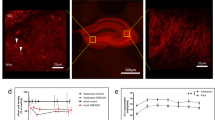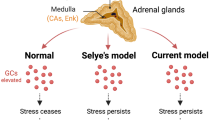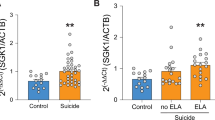Abstract
Clinical investigations present much evidence that the glucocorticoid receptor (GR) antagonist mifepristone leads to a rapid amelioration of depression. The molecular mechanisms of mifepristone involved in the treatment of depression are not fully understood. Depression is associated with hippocampal plasticity, for which increased excitatory amino acid (EAA) release in CA3 induced by chronic stress is responsible, and glucocorticoids have a permissive role and act synergistically with EAAs in producing neuronal damage. Moreover, glucocorticoids increase synapsin I, which has a key role in the release of neurotransmitter, including EAAs. Hereby, we hypothesize that major depression involves synapsin I alteration and that mifepristone blocks this alteration. In the present study, we observed both the expression of hippocampal synapsin I and depression-associated behavior in a rat model of depression induced by chronic unpredictable mild stress (CUMS). The result showed that a region-dependent synapsin I alteration occurs in the rat hippocampus after 21 days of CUMS, that is, it increases in dentate gyrus (DG)/CA3 and decreases in the CA1 region. Correlation analysis indicated that the decrease of synapsin I in CA1 is highly correlated with the increase in the DG/CA3 subfield. Simultaneously, the region-dependent alteration of synapsin I is correlated with depression-associated behaviors. Both the alteration of synapsin I and the depression-associated behavior were rapidly restored after treatment with mifepristone for 1 week. The result suggests that the molecular mechanism underlying the treatment of depression with mifepristone is associated with the rapid repair of the synaptic alteration.
Similar content being viewed by others
Log in or create a free account to read this content
Gain free access to this article, as well as selected content from this journal and more on nature.com
or
References
Ayensu WK, Pucilowski O, Mason GA, Overstreet DH, Rezvani AH, Janowsky DS (1995). Effects of chronic mild stress on serum complement activity, saccharin preference, and corticosterone levels in Flinders lines of rats. Physiol Behav 57: 165–169.
Bartanusz V, Aubry JM, Pagliusi S, Jezova D, Baffi J, Kiss JZ (1995). Stress-induced changes in messenger RNA levels of N-methyl-D-aspartate and AMPA receptor subunits in selected regions of the rat hippocampus and hypothalamus. Neuroscience 66: 247–252.
Belanoff JK, Flores BH, Kalezhan M, Sund B, Schatzberg AF (2001). Rapid reversal of psychotic depression using mifepristone. J Clin Psychopharmacol 21: 516–521.
Belanoff JK, Rothschild AJ, Cassidy F, DeBattista C, Baulieu EE, Schold C et al (2002). An open label trial of C-1073 (mifepristone) for psychotic major depression. Biol Psychiatry 52: 386–392.
Berton O, Nestler EJ (2006). New approaches to antidepressant drug discovery: beyond monoamines. Nat Rev Neurosci 7: 137–151.
Bremner JD, Narayan M, Anderson ER, Staib LH, Miller HL, Charney DS (2000). Hippocampal volume reduction in major depression. Am J Psychiatry 157: 115–118.
Brunson KL, Eghbal-Ahmadi M, Bender R, Chen Y, Baram TZ (2001). Long-term, progressive hippocampal cell loss and dysfunction induced by early-life administration of corticotropin-releasing hormone reproduce the effects of early-life stress. Proc Natl Acad Sci USA 98: 8856–8861.
Cadepond F, Ulmann A, Baulieu EE (1997). RU486 (mifepristone): mechanisms of action and clinical uses. Annu Rev Med 48: 129–156.
De Camilli P, Benfenati F, Valtorta F, Greengard P (1990). The synapsins. Annu Rev Cell Biol 6: 433–460.
De Vry J, Schreiber R (1997). The chronic mild stress depression model: future developments from a drug discovery perspective. Psychopharmacology (Berl) 134: 349–350; discussion 371–347.
Flores BH, Kenna H, Keller J, Solvason HB, Schatzberg AF (2006). Clinical and biological effects of mifepristone treatment for psychotic depression. Neuropsychopharmacology 31: 628–636.
Frodl T, Meisenzahl EM, Zetzsche T, Born C, Groll C, Jager M et al (2002). Hippocampal changes in patients with a first episode of major depression. Am J Psychiatry 159: 1112–1118.
Gass P, Kretz O, Wolfer DP, Berger S, Tronche F, Reichardt HM et al (2000). Genetic disruption of mineralocorticoid receptor leads to impaired neurogenesis and granule cell degeneration in the hippocampus of adult mice. EMBO Rep 1: 447–451.
Hall C (1934). Emotional behavior in the rat. I. Defecation and urination as measures of individual differences in emotionality. J Comp Psychol 18: 385–403.
Holsboer F, Barden N (1996). Antidepressants and hypothalamic-pituitary-adrenocortical regulation. Endocr Rev 17: 187–205.
Hu XY, Qin S, Lu YP, Ravid R, Swaab DF, Zhou JN (2003). Decreased estrogen receptor-alpha expression in hippocampal neurons in relation to hyperphosphorylated tau in Alzheimer patients. Acta Neuropathol (Berl) 106: 213–220.
Hu XY, Zhang HY, Qin S, Xu H, Swaab DF, Zhou JN (2002). Increased p75(NTR) expression in hippocampal neurons containing hyperphosphorylated tau in Alzheimer patients. Exp Neurol 178: 104–111.
Huttner WB, Schiebler W, Greengard P, De Camilli P (1983). Synapsin I (protein I), a nerve terminal-specific phosphoprotein. III. Its association with synaptic vesicles studied in a highly purified synaptic vesicle preparation. J Cell Biol 96: 1374–1388.
Iwata M, Shirayama Y, Ishida H, Kawahara R (2006). Hippocampal synapsin I, growth-associated protein-43, and microtubule-associated protein-2 immunoreactivity in learned helplessness rats and antidepressant-treated rats. Neuroscience 141: 1301–1313.
Jacobson L, Sapolsky R (1991). The role of the hippocampus in feedback regulation of the hypothalamic-pituitary-adrenocortical axis. Endocr Rev 12: 118–134.
Katz RJ, Roth KA, Carroll BJ (1981). Acute and chronic stress effects on open field activity in the rat: implications for a model of depression. Neurosci Biobehav Rev 5: 247–251.
Krugers HJ, Goltstein PM, van der Linden S, Joels M (2006). Blockade of glucocorticoid receptors rapidly restores hippocampal CA1 synaptic plasticity after exposure to chronic stress. Eur J Neurosci 23: 3051–3055.
Krugers HJ, Koolhaas JM, Bohus B, Korf J (1993). A single social stress-experience alters glutamate receptor-binding in rat hippocampal CA3 area. Neurosci Lett 154: 73–77.
Li L, Chin LS, Shupliakov O, Brodin L, Sihra TS, Hvalby O et al (1995). Impairment of synaptic vesicle clustering and of synaptic transmission, and increased seizure propensity, in synapsin I-deficient mice. Proc Natl Acad Sci USA 92: 9235–9239.
Liu RY, Zhou JN, Hoogendijk WJ, van Heerikhuize J, Kamphorst W, Unmehopa UA et al (2000). Decreased vasopressin gene expression in the biological clock of Alzheimer disease patients with and without depression. J Neuropathol Exp Neurol 59: 314–322.
Magarinos AM, McEwen BS (1995a). Stress-induced atrophy of apical dendrites of hippocampal CA3c neurons: involvement of glucocorticoid secretion and excitatory amino acid receptors. Neuroscience 69: 89–98.
Magarinos AM, McEwen BS (1995b). Stress-induced atrophy of apical dendrites of hippocampal CA3c neurons: comparison of stressors. Neuroscience 69: 83–88.
Magarinos AM, McEwen BS, Flugge G, Fuchs E (1996). Chronic psychosocial stress causes apical dendritic atrophy of hippocampal CA3 pyramidal neurons in subordinate tree shrews. J Neurosci 16: 3534–3540.
Magarinos AM, Verdugo JM, McEwen BS (1997). Chronic stress alters synaptic terminal structure in hippocampus. Proc Natl Acad Sci USA 94: 14002–14008.
McEwen BS (1999). Stress and hippocampal plasticity. Annu Rev Neurosci 22: 105–122.
McEwen BS, Magarinos AM (1997). Stress effects on morphology and function of the hippocampus. Ann NY Acad Sci 821: 271–284.
Monaghan DT, Holets VR, Toy DW, Cotman CW (1983). Anatomical distributions of four pharmacologically distinct 3H-L-glutamate binding sites. Nature 306: 176–179.
Muller MB, Lucassen PJ, Yassouridis A, Hoogendijk WJ, Holsboer F, Swaab DF (2001). Neither major depression nor glucocorticoid treatment affects the cellular integrity of the human hippocampus. Eur J Neurosci 14: 1603–1612.
Muscat R, Willner P (1992). Suppression of sucrose drinking by chronic mild unpredictable stress: a methodological analysis. Neurosci Biobehav Rev 16: 507–517.
Nestler EJ, Rainbow TC, McEwen BS, Greengard P (1981). Corticosterone increases the amount of protein 1, a neuron-specific phosphoprotein, in rat hippocampus. Science 212: 1162–1164.
Pawlak R, Rao BS, Melchor JP, Chattarji S, McEwen B, Strickland S (2005). Tissue plasminogen activator and plasminogen mediate stress-induced decline of neuronal and cognitive functions in the mouse hippocampus. Proc Natl Acad Sci USA 102: 18201–18206.
Rapp S, Baader M, Hu M, Jennen-Steinmetz C, Henn FA, Thome J (2004). Differential regulation of synaptic vesicle proteins by antidepressant drugs. Pharmacogenomics J 4: 110–113.
Sapolsky RM, Uno H, Rebert CS, Finch CE (1990). Hippocampal damage associated with prolonged glucocorticoid exposure in primates. J Neurosci 10: 2897–2902.
Sheline YI, Wang PW, Gado MH, Csernansky JG, Vannier MW (1996). Hippocampal atrophy in recurrent major depression. Proc Natl Acad Sci USA 93: 3908–3913.
Simpson GM, El Sheshai A, Loza N, Kingsbury SJ, Fayek M, Rady A et al (2005). An 8-week open-label trial of a 6-day course of mifepristone for the treatment of psychotic depression. J Clin Psychiatry 66: 598–602.
Thiel G (1993). Synapsin I, synapsin II, and synaptophysin: marker proteins of synaptic vesicles. Brain Pathol 3: 87–95.
Traub RD, Miles R (1991). Neuronal Networks of the Hippocampus. Cambridge University Press: Cambridge.
Uno H, Tarara R, Else JG, Suleman MA, Sapolsky RM (1989). Hippocampal damage associated with prolonged and fatal stress in primates. J Neurosci 9: 1705–1711.
Vawter MP, Thatcher L, Usen N, Hyde TM, Kleinman JE, Freed WJ (2002). Reduction of synapsin in the hippocampus of patients with bipolar disorder and schizophrenia. Mol Psychiatry 7: 571–578.
Watanabe Y, Gould E, McEwen BS (1992). Stress induces atrophy of apical dendrites of hippocampal CA3 pyramidal neurons. Brain Res 588: 341–345.
Willner P (1997). Validity, reliability and utility of the chronic mild stress model of depression: a 10-year review and evaluation. Psychopharmacology (Berl) 134: 319–329.
Willner P, Towell A, Sampson D, Sophokleous S, Muscat R (1987). Reduction of sucrose preference by chronic unpredictable mild stress, and its restoration by a tricyclic antidepressant. Psychopharmacology (Berl) 93: 358–364.
Wong ML, Licinio J (2004). From monoamines to genomic targets: a paradigm shift for drug discovery in depression. Nat Rev Drug Discov 3: 136–151.
Young AH, Gallagher P, Watson S, Del-Estal D, Owen BM, Ferrier IN (2004). Improvements in neurocognitive function and mood following adjunctive treatment with mifepristone (RU-486) in bipolar disorder. Neuropsychopharmacology 29: 1538–1545.
Acknowledgements
We are grateful to Ms Wilma Verweij for language editing and to Mr Ji Liu and Miss Yong-Yong Zhu for their help with the experiments. This research was supported by the Ministry of Science and Technology of China (2006CB500705) and the Natural Science Foundation of China (30530310).
Author information
Authors and Affiliations
Corresponding author
Rights and permissions
About this article
Cite this article
Wu, LM., Han, H., Wang, QN. et al. Mifepristone Repairs Region-Dependent Alteration of Synapsin I in Hippocampus in Rat Model of Depression. Neuropsychopharmacol 32, 2500–2510 (2007). https://doi.org/10.1038/sj.npp.1301386
Received:
Revised:
Accepted:
Published:
Issue date:
DOI: https://doi.org/10.1038/sj.npp.1301386
Keywords
This article is cited by
-
Paeoniflorin attenuates impairment of spatial learning and hippocampal long-term potentiation in mice subjected to chronic unpredictable mild stress
Psychopharmacology (2019)
-
Chronic stress impairs the aquaporin-4-mediated glymphatic transport through glucocorticoid signaling
Psychopharmacology (2019)
-
Programming for increased expression of hippocampal GAD67 mediated the hypersensitivity of the hypothalamic–pituitary–adrenal axis in male offspring rats with prenatal ethanol exposure
Cell Death & Disease (2018)
-
CRHR1 Mediates the Up-Regulation of Synapsin I Induced by Nesfatin-1 Through ERK 1/2 Signaling in SH-SY5Y Cells
Cellular and Molecular Neurobiology (2018)
-
Glucocorticoid receptor activation induces decrease of hippocampal astrocyte number in rats
Psychopharmacology (2018)



